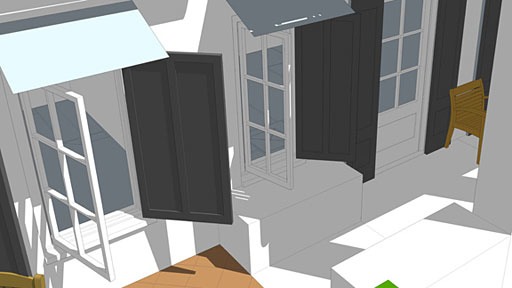
SmartDwelling I has the distinction of being the only one of the four houses published recently by the Wall Street Journal in their Green House of the Future article that could be built today. Or at least 98% of what was shown can currently be built. One of the few exceptions are the windows and shutters. That might be about to change.
Casement windows are easier to make airtight than double-hung windows because the sash squeezes the weatherstripping tight to the frame when the window closes instead of sliding along the surface of the weatherstripping like double-hung sashes must do. But casements have a problem: If you’re in a region like the Gulf Coast (for which SmartDwelling I was designed) which is frequented by hurricanes, then you really need to be able to close solid shutters over your windows to protect them from the storm. But how do you close the shutters once the window is closed? Southern European casements solve this problem by opening the casements inward rather than outward, but inward-opening casements almost always leak in a blowing rainstorm. This might be tolerable in the milder climate of southern Europe, but not on the Gulf Coast. Until now, the only choice was to close the shutters from outside the house... perched on a ladder for most windows. That’s why shuttered casements are almost non-existent there.
Until now, that is. One of the major epiphanies of SmartDwelling I occurred when I asked myself “if you can crank the casement sashes open and closed, why not crank the shutters, too?” Presto... we now have the superior weathertightness of a casement with the protection of a shutter that can be operated from indoors. But that’s not all. Notice how a casement on a crank can be opened to any position you like and left there? Well, now you can do the same thing with a shutter. As a result, you can aim the sash & shutter at the prevailing breezes, channeling air into the room. And if you open them slightly wider, where they don’t exactly line up like the ones shown above, then it literally creates a funnel shape to transform a small breath of air into a more noticeable breeze.
“That’s great,” you might say, “but why are you telling me this if I can’t buy windows like that today?” Because now we’re talking to a window manufacturer that’s strongly considering making them! I won’t reveal who it is until they’re committed to the project, but I’m really excited that this could happen quickly. As a result of this encouraging turn of events, I’m working to get the remainder of the futuristic components of SmartDwelling I on the assembly line, too. More later…
~ Steve Mouzon
Legacy Comments:
Friday, May 22, 2009 - 11:49 AM
Lloyd Alter
I acknowledge that you get a better seal on a casement window, but I always thought double-hungs were best because you could "tune" them for maximum ventilation and convection by adjusting the top and bottom openings.
Friday, May 22, 2009 - 05:43 PM
Michael Rouchell
I like the idea that the windows and the shutters can be by the same source. single source = single responsibility. I also like that the window and shutter by a single source can be tested as a system.
Tuesday, May 26, 2009 - 06:54 PM
Steve Mouzon
Lloyd, you have a point about double-hungs working well for ventilation on a still day... warm air goes out at the top, and cool air comes in at the bottom. An open casement does the same thing, but a double-hung doesn't have to be fully open to produce the same result. Actually, a double-hung is never fully open... it can't open more than 50%. So if a shower came up, then the double-hung wouldn't allow as much rain. But you definitely get more air in through a casement, especially with shutters like this.
Michael, I hadn't thought of the testing angle on the window/shutter system... that's a great idea! What this means is that you really could use a wind-rated but not impact-rated window in a hurricane zone because the shutter takes the impact. That could save a good bit of money, unless the crank system is extremely expensive.
Tuesday, May 26, 2009 - 07:35 PM
Michael Rouchell
Steve, I don't think that the crank mechanism would necessarily need to be anything unusual since you wouldn't likely be operating the windows during a hurricane. The shutters should have some kind of surface bolt at the top and bottom, or some kind of latch that can withstand the forces of the wind. The shutter hinge connection must also be properly engineered, and if it is a component of the window, then you don't have two different manufacturers (shutter and window) blaming each other if a component fails. That's why I think the windows and shutters should be from a single source and manufacturer.
Monday, November 9, 2009 - 07:26 PM
Robert Sharp
Steve,
An additional advantage of the cranked open adjustable shutter is that it would be a very effective way to block east and west sun and still allow air flow. And crankable shutter helps solve the insect screen problem. I think that the retractable (roll-up) screen would be best for this application, so that you could have a completely tunable system for air flow, shading, and insect repelling. In our climate we have many days early in the Spring and late in the Fall when the bugs are all gone, but the weather is nice and you want to completely open the window and not look at an unnecessary insect screen.


